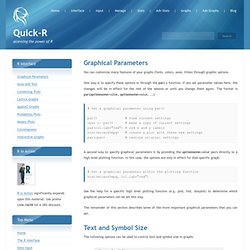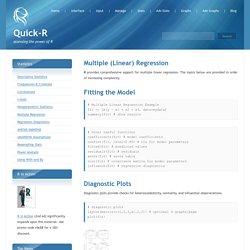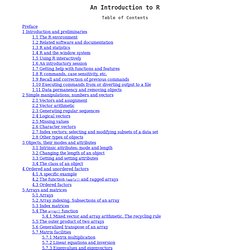

Shiny - Gallery. Welcome · Advanced R. Graphical Parameters. You can customize many features of your graphs (fonts, colors, axes, titles) through graphic options.

One way is to specify these options in through the par( ) function. If you set parameter values here, the changes will be in effect for the rest of the session or until you change them again. The format is par(optionname=value, optionname=value, ...) # Set a graphical parameter using par() par() # view current settings opar <- par() # make a copy of current settings par(col.lab="red") # red x and y labels hist(mtcars$mpg) # create a plot with these new settings par(opar) # restore original settings A second way to specify graphical parameters is by providing the optionname=value pairs directly to a high level plotting function. . # Set a graphical parameter within the plotting function hist(mtcars$mpg, col.lab="red") See the help for a specific high level plotting function (e.g. plot, hist, boxplot) to determine which graphical parameters can be set this way. Text and Symbol Size Lines Colors.
R Graph Gallery. Multiple Regression. R provides comprehensive support for multiple linear regression.

The topics below are provided in order of increasing complexity. Fitting the Model # Multiple Linear Regression Example fit <- lm(y ~ x1 + x2 + x3, data=mydata) summary(fit) # show results # Other useful functions coefficients(fit) # model coefficients confint(fit, level=0.95) # CIs for model parameters fitted(fit) # predicted values residuals(fit) # residuals anova(fit) # anova table vcov(fit) # covariance matrix for model parameters influence(fit) # regression diagnostics Diagnostic Plots Diagnostic plots provide checks for heteroscedasticity, normality, and influential observerations. # diagnostic plots layout(matrix(c(1,2,3,4),2,2)) # optional 4 graphs/page plot(fit) click to view For a more comprehensive evaluation of model fit see regression diagnostics.
Comparing Models You can compare nested models with the anova( ) function. Cross Validation You can assess R2 shrinkage via K-fold cross-validation. Variable Selection. Cran.r-project.org/web/packages/date/date.pdf. A Community Site for R – Sponsored by Revolution Analytics. Revolution R. The Workspace. The workspace is your current R working environment and includes any user-defined objects (vectors, matrices, data frames, lists, functions).

At the end of an R session, the user can save an image of the current workspace that is automatically reloaded the next time R is started. Commands are entered interactively at the R user prompt. Up and down arrow keys scroll through your command history. You will probably want to keep different projects in different physical directories. Here are some standard commands for managing your workspace. IMPORTANT NOTE FOR WINDOWS USERS: R gets confused if you use a path in your code like c:\mydocuments\myfile.txt This is because R sees "\" as an escape character. Getwd() # print the current working directory - cwd ls() # list the objects in the current workspace setwd(mydirectory) # change to mydirectory setwd("c:/docs/mydir") # note / instead of \ in windows setwd("/usr/rob/mydir") # on linux. An Introduction to R. Table of Contents This is an introduction to R (“GNU S”), a language and environment for statistical computing and graphics.

R is similar to the award-winning1 S system, which was developed at Bell Laboratories by John Chambers et al. It provides a wide variety of statistical and graphical techniques (linear and nonlinear modelling, statistical tests, time series analysis, classification, clustering, ...). This manual provides information on data types, programming elements, statistical modelling and graphics. This manual is for R, version 3.1.0 (2014-04-10). Copyright © 1990 W. Permission is granted to make and distribute verbatim copies of this manual provided the copyright notice and this permission notice are preserved on all copies.
Preface This introduction to R is derived from an original set of notes describing the S and S-PLUS environments written in 1990–2 by Bill Venables and David M. Comments and corrections are always welcome. Suggestions to the reader. Home Page. Getting Started in R.